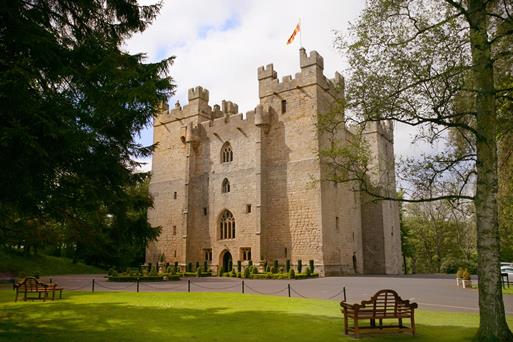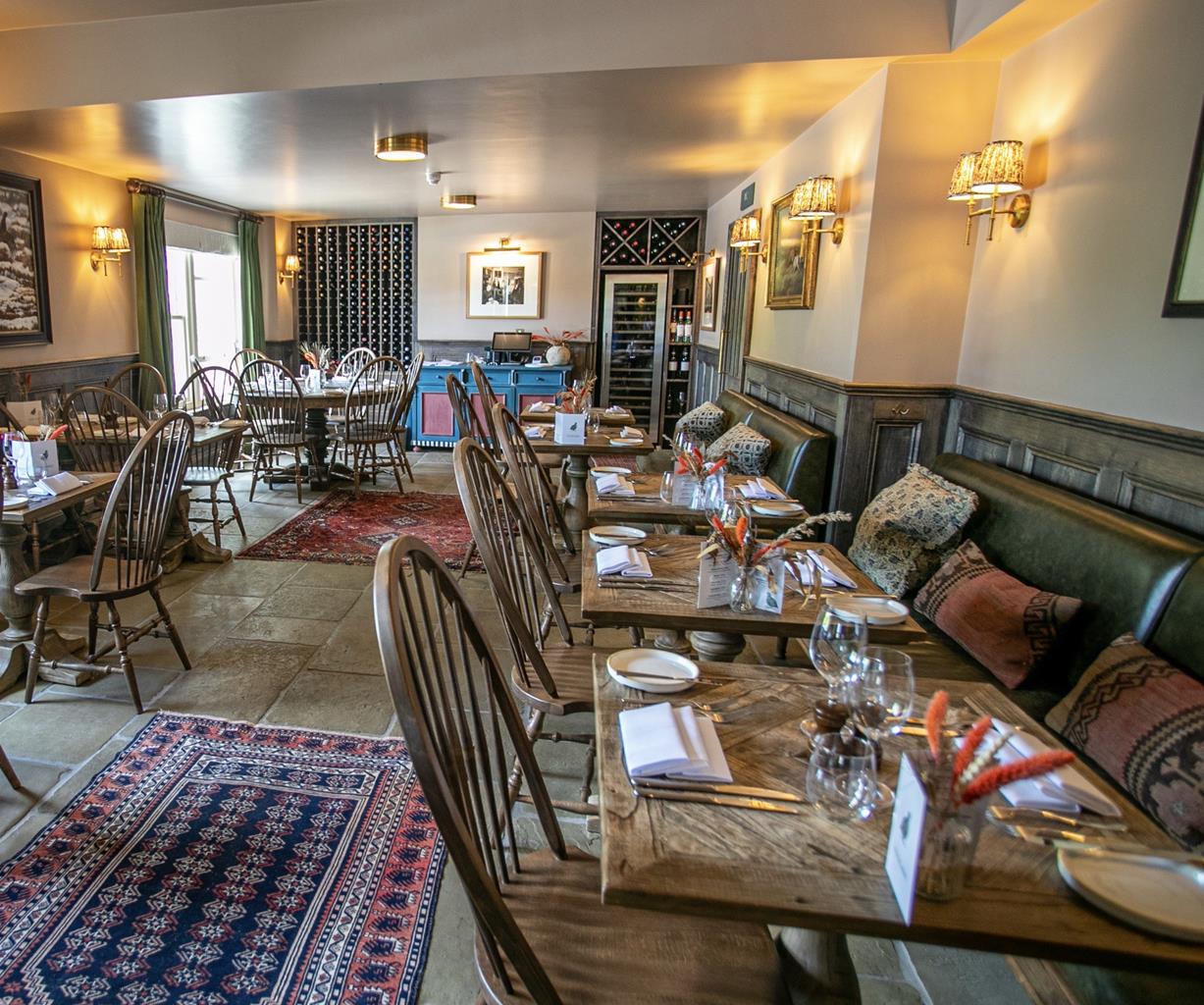Lord Crewe Arms is set in the tranquil and picturesque Northumbrian countryside and dates back…
Blanchland

3.75 miles (6kms)
About the walk
One of northern England's prettiest villages, Blanchland owes its beginnings to a Premonstratensian priory founded in 1165. Despite later elevation to an abbey, it only ever housed a small community, who lived in austere seclusion in this wooded river valley on the edge of the moors.
Border troubles
Living under the sign of the cross gave little protection against border reivers and, although it was never a rich house, the abbey suffered more than one attack over the years. One tale tells how a group of Scots intent on pillage became lost in the mist and had actually moved on past the abbey. Unfortunately, as they were heading away, the monks prematurely began ringing the bells to celebrate their deliverance. The sound drifted across the moors and the raiders turned back to sack the abbey and its village. The canons may have been equally unsettled by a visit from Edward III during a campaign against the Scots. Luckily for the abbey there was no battle, but the mere fact of having to provide hospitality for the royal guest and his entourage, as well suffer a foraging army living off the land, would have been almost as disastrous. Like other religious houses, the abbey offered hospitality to travellers and because of its position in a remote area where little else was available it was granted a short stay of execution under Henry's Dissolution. But the end finally came just three years later in 1539 and the monastery was closed down, although a portion of the abbey church was retained as the parish church.
A model village rises from the ruins
By the beginning of the 18th century the monastery was in ruins, with only the gate house and the abbot's lodgings, which had been converted into a manor house, still standing. By then the estate was held by the Forsters, who were encumbered with debt, and it passed to Dorothy, wife of Baron Crewe, then Bishop of Durham. He paid off the debts and after his death left the estate within a charitable trust, which rebuilt the village as it stands today, using the ready prepared stone that lay about from the monastic ruins.
Lead mining
Like many other communities in the area, Blanchland made a living out of lead and silver. The rich veins of Weardale and Allendale lay only a few miles to the south and west respectively, and outcropped again here in the hills enclosing the upper Derwent Valley. Small-scale surface quarrying and bell pit mining had been undertaken throughout the Middle Ages, but the advent of steam power in the industrial age enabled deeper workings by pumping out water and lifting the ore from great depths. For a short time at the beginning of the 19th century Blanchland prospered, but the deposits became exhausted and foreign imports finally killed the industry.
Walk directions
Turn left out of the car park along the lane. Just after crossing a stream, leave along a track on the left signed to Cote House Farm. Where it later bends right towards the farmhouse, go through a kissing gate on the left. Follow the fence to a stile and gate by power cable posts. Head away along a grass track leads, taking the left fork, which slants across the slope of the field towards cottages at the bottom. Exit over a ladder stile at the bottom onto a lane.
Follow the lane right, bending past a junction and the Baybridge Picnic Area. Over a bridge, just past a lane off to the right, turn left through a gateway by a footpath sign into a wood. Almost immediately, cross a stream then bear off right at a waypost to climb between the trees. Through a kissing gate at the top, go half right across a field, joining the long fence to climb to the top corner. Through a gate on the left, walk away on a track, swinging right around a wall corner. After passing through a second gate, abandon the track and revert to the right-hand wall. Go through yet another gate and continue with the wall to the lane at the far end of the field.
Walk left past Allenshields Farm and shortly after reach a small, isolated stone barn. Leave immediately before it through a hand gate and head away beside the right-hand wall. About three-quarters of the way downfield, cross a ladder stile and walk away next to the wall. Over another stile in the corner, cross a slab bridge and carry on, joining the left fence to emerge onto a lane opposite a Rope Barn.
Head downhill, keeping left when you reach the main road to cross back over the River Derwent. On the far bank, double back sharp-right beside a sign to Carrick along a narrow passage to the riverbank, and follow the path downstream. Take care as the path is occasionally narrow beside the river.
After a mile (1.6km), reaching a junction of tracks, turn left away from the river along a grass bridleway, signed to Blanchland. After a slight climb, it curves left to run pleasantly between sparse, flower-rich hedges.
Emerging onto the B6306, keep ahead back to the village. Before returning to your car, wander left to visit the abbey church and ruins, and pass beside the gatehouse to see the picturesque square overlooked by the Lord Crewe Arms.
Additional information
Tracks and field paths, two short climbs, 4 stiles
Village and wooded farmland
On lead, except final riverside path from Blanchland Bridge
AA Walker's Map 29 Hadrian's Wall
Blanchland car park, at north edge of village; honesty box
Blanchland, near bridge
WALKING IN SAFETY
Read our tips to look after yourself and the environment when following this walk.
Find out more
Also in the area
About the area
Discover Northumberland
If it’s history you’re after, there’s heaps of it in Northumberland. On Hadrian’s Wall you can imagine scarlet-cloaked Roman legionaries keeping watch for painted Pictish warriors while cursing the English weather and dreaming of home. Desolate battlefield sites and hulking fortresses such as Alnwick, Dunstanburgh, Bamburgh and Warkworth are reminders that this, until not so very long ago, was a contested border region. The ruins of Lindisfarne bear witness to the region’s early Christian history.
Northumberland also has some of Britain’s best beaches. On summer days, and even in winter, you’ll see surfers and other brave souls making the most of the coast. Inland, there are some great walks and bike rides in the dales of the Cheviot Hills and the Simonsides – just hilly enough to be interesting, without being brutally steep. There's dramatic scenery in the High Pennines, where waterfalls plunge into deep valleys, and there are swathes of heather-scented moorland. Northumberland National Park covers over 400 square miles of moorland and valleys with clear streams and pretty, stone-built villages. It’s just the place for wildlife watching too. You’ll find flocks of puffins, guillemots and other seabirds around the Farne Islands, and seals and dolphins offshore.
Nearby stays
Restaurants and Pubs
Nearby experiences
Recommended things to do
Why choose Rated Trips?
Your trusted guide to rated places across the UK
The best coverage
Discover more than 15,000 professionally rated places to stay, eat and visit from across the UK and Ireland.
Quality assured
Choose a place to stay safe in the knowledge that it has been expertly assessed by trained assessors.
Plan your next trip
Search by location or the type of place you're visiting to find your next ideal holiday experience.
Travel inspiration
Read our articles, city guides and recommended things to do for inspiration. We're here to help you explore the UK.

















